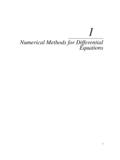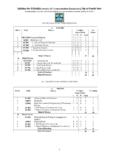Transcription of Tolerance Allocation Methods for Designers
1 Tolerance Allocation Methods for Designers ADCATS Report No. 99-6. Kenneth W. Chase Department of Mechanical engineering Brigham Young University 1999. ABSTRACT. Tolerance Allocation is a design tool. It provides a rational basis for assigning tolerances to dimensions. Several algorithms are described in this paper for performing Tolerance Allocation , which is defined as the re-distribution of the Tolerance budget within an assembly to reduce over-all cost of production, while meeting target levels for quality. The task of placing +/- tolerances on each dimension of a CAD model or set of engineering drawings may seem menial and of little consequence. However, it can have enormous impact on cost and quality.
2 On the engineering design side, it affects the fit and function of the final product, which can cause poor performance and dissatisfied customers. On the manufacturing side, Tolerance requirements determine the selection of machines, tooling and fixtures; operator skill levels and setup costs; inspection precision and gaging; and scrap and rework. In short, it affects nearly every aspect of the product life cycle. Using the new CAD-based Tolerance analysis tools, Designers can perform variation analysis on the CAD model, before parts are made or tooling purchased. They can determine where Tolerance controls are needed and how tight the limits must be set, to assist in process planning and tool design.
3 Using the same CAD model, production personnel can use Tolerance tools to determine whether marginal or out-of-spec parts can still be used. Tolerance analysis tools provide a quantitative basis for design for manufacture decisions, resulting in shorter product development time and increased quality. There is probably no other design improvement effort which can yield greater benefits for less cost than the careful analysis and assignment of tolerances. Tolerance Allocation Methods for Designers Kenneth W. Chase Mechanical engineering Department Brigham Young University Improving Quality by Tolerancing Techniques There are several advanced tolerancing techniques available to a designer to improve quality levels in assemblies.
4 They are primarily fine-tuning operations which can be applied to an assembly distribution to reduce the number of rejected assemblies, sometimes dramatically. The three Methods to be presented here are: 1 Centering the Mean of the Assembly Distribution 2 Upper or Lower Limit Justification of the Mean 3 Reducing the Spread of the Distribution When bringing a manufacturing process for a new product on line, small lots are produced to qualify the tooling. Parts are assembled, critical assembly features are measured and the mean and standard deviation of the resulting distributions are calculated. It is often found that the mean of the assembly distribution is not symmetrically distributed with respect to the upper and lower design specification limits (USL and LSL), resulting in large numbers of rejects at one or the other design limit.
5 This can be caused by tooling bias, setup error, shrinkage of molded or cast parts, or other factors. If the errors are systematic, adjustments must be made to the tooling or processes to center the distribution. By centering the distribution, the total number of rejects can be minimized. If only one limit is critical, as with a minimum clearance specification, the mean may be shifted away from the constraining limit until the desired quality level is reached. These operations are depicted in Fig. 1. LSL USL. Centered Original Distribution x USL LSL. LSL USL. USL Justified x x +Zasm . USL. LSL LSL Justified -Zasm x Figure 1. Effects of mean shift operations Centering the Mean of the Assembly Distribution Centering the mean puts the greatest distance between the Tolerance limits and the mean, thus minimizing the number of rejects for a given assembly Tolerance distribution.
6 By adjusting one or more component nominals, the assembly mean may be moved to the center, halfway between the USL and LSL. Clearly, the centered distribution will have fewer rejects. Note that adjustments to the mean do not involve tightening any tolerances, nor do tightening tolerances affect the mean. To tighten a Tolerance may require switching to a more expensive process or creation of special fixtures, in which case adjusting the nominal dimension of a component may be less costly. Deciding which component nominals to change is a design decision. Some components may be vendor-supplied and not allowed to change. Others may be too costly to change due to tooling modifications or other requirements.
7 Some may simply require a change in the program of an NC machine used in its production. Of course, if the assembly is in production, the fewer parts you have to change, the better. If more than one nominal is to be changed, a set of weight factors may be used for Allocation of component nominals. The designer sets the value of the weight factors corresponding to those components he wishes to change. The relative weights determine how much change is assigned to each component. Upper or Lower Limit Justification of the Mean Small changes may also be made to individual nominal dimensions to shift the nominal spec towards either the upper or lower spec limit. This may be desirable if there is only one spec limit or if one of the two spec limits is more important than the other.
8 As with the centering Allocation , the distribution is simply shifted without changing its spread. For example, a minimum clearance (LSL) may be critical to an assembly, but the maximum clearance may not be important. In USL justification, the center of the distribution is shifted such that the +Zasm limit matches with the USL, where is the standard deviation of the assembly variation and Zasm is the desired quality level expressed in standard deviations. Similarly, in LSL justification, the distribution is shifted such that the -Zasm limit matches with the LSL. Variance Adjustment If the mean has been centered and the reject rate is still too high because the spread of the distribution is too broad, it will be necessary to tighten tolerances on one or more assembly component dimensions to reduce the standard deviation of the assembly, as shown in Fig.
9 2. Original Distribution Reduced Variation LSL USL LSL USL. x x Figure 2. Effects of reduced variation All three nominal Allocation Methods may be used in conjunction with any Tolerance Allocation method to simultaneously shift the mean and change the spread of the distribution. Tolerance Analysis vs. Tolerance Allocation The analytical modeling of assemblies provides a quantitative basis for the evaluation of design variations and specification of tolerances. An important distinction in Tolerance specification is that engineers are more commonly faced with the problem of Tolerance Allocation rather than Tolerance analysis. The difference between these two problems is illustrated in Fig.
10 3. In Tolerance analysis the component tolerances are all known or specified and the resulting assembly variation is calculated. In Tolerance Allocation , on the other hand, the assembly Tolerance is known from design requirements, whereas the magnitude of the component tolerances to meet these requirements are unknown. The available assembly Tolerance must be distributed or allocated among the components in some rational way. The influence of the Tolerance accumulation model and the Allocation rule chosen by the designer on the resulting Tolerance Allocation will be demonstrated. Tolerance Analysis Tolerance Allocation Component Component Tolerances Tolerances Assembly Assembly Tolerance Tolerance Allocation Assembly Scheme Function Acceptance Acceptance Fraction Fraction Figure 3.








